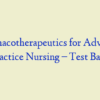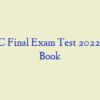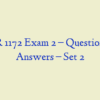Description
FIN 534 Final Exam – Question and Answers
- A $1,000 par value bond with a fixed 10% rate of interest pays coupons semiannually. What amount will the bondholder receive on the bond’s maturity date?
- You bought a yen-denominated corporate bond at the beginning of the year for ¥100,000. The bond paid 3 percent annual interest and was trading for ¥110,000 at year-end. The exchange rate was $1 = ¥100 at the beginning of the year and $1 = ¥122 at year-end. What holding period return, measured in U.S. dollars, did you earn on the bond?
- Ginormous Oil entered into an agreement to purchase all of the outstanding shares of Slick Company for $60 per share. The number of outstanding shares at the time of the announcement was 82 million. The book value of liabilities on the balance sheet of Slick Co. was $1.46 billion. Immediately prior to the Ginormous Oil bid, the shares of Slick Co. traded at $33 per share. What value did Ginormous Oil place on the control of Slick Co.?
- Tutter Corporation is being valued using discounted cash flow methodology with terminal value calculated as a growing perpetuity. Not including the terminal value, the present value of projected free cash flows for years 1 through 5 is $200 million (total). In year 5, projections show free cash flow of $60 million. What is the estimated fair market value of Tutter Corporation? Assume a WACC of 10% and a growth rate of 2%.
- A recent annual income statement for Stone Creek Roofing showed the information below. Net sales $5,000 Cost of sales $3,200 Gross profit $1,800 Operating expense $800 Depreciation expense $200 Operating income $800 Interest expense $100 Income before tax $700 Tax $175 Income after tax $525 Assume that during the year, Stone Creek spent $180 on new capital equipment and increased current assets net of non-interest-bearing current liabilities by $120. What was Stone Creek’s free cash flow in this year?
- Which of the following statements is correct if a firm’s pro forma financial statements project net income of $12,000 and external financing required of $5,000?
- Which of the following are viable techniques to cope with the uncertainty inherent in realistic financial projections? I. Simulation II. Ad hoc adjustments III. Scenario analysis IV. Sensitivity analysis
- You are estimating your company’s external financing needs for the next year. Your first-pass pro forma financial statements showed a large financing deficit for next year. Which of the following changes to your company’s operating plan would reduce the financing deficit if incorporated in revised pro forma financial statements?
- Which of the following securities has a purely residual claim against a firm’s cash flows?
- The price of a call option tends to be lower when which of the following is higher (all else equal)?
- Which of the following statements are true? I. Underwriters help private companies access public stock markets through IPOs. II. Shelf registrations and private placements are examples of seasoned security issues. III. Issue costs for debt are typically greater than issue costs for equity. IV. Bearer bonds make it easier for investors to avoid paying taxes on interest income.
- Mike just purchased a bond which pays $40 every six months in interest. The $40 interest payment is also called the
- Which of the following variables does NOT affect the value of a stock option?
- Which of the following are the most likely reasons for why a stock price might not react at all on the day that new information related to the stock issuer is released? I. Insiders knew the information prior to the announcement. II. Investors need time to digest the information prior to reacting. III. The information has no bearing on the value of the firm. IV. The information was anticipated.
- Which of the following factors, when increased, will tend to cause the value of a put to decrease (all else equal)?
- Which one of the following accurately orders the rate of return on financial securities from highest to lowest over most of recorded market history (the 1928-2016 period)?
- Which of the following is NOT likely to be a prudent financing policy for a rapidly growing business?
- Which of the following factors favor the issuance of debt in the financing decision? I. Market signaling II. Distress costs III. Tax benefits IV. Financial flexibility
- The basic lesson of the M&M theory is that the value of a firm is dependent upon
- The term “financial distress costs” includes which of the following? I. Direct bankruptcy costs II. Indirect bankruptcy costs III. Direct costs related to being financially distressed but not bankrupt IV. Indirect costs related to being financially distressed but not bankrupt
- Which of the following statements regarding interest tax shields is correct?
- According to the pecking order theory of capital structure, why do firms avoid issuing equity?
- Which of the following is NOT an implication of the pecking order theory of capital structure?
- Which of the following is/are helpful for evaluating the effect of leverage on a company’s risk and potential returns? I. Estimated pro forma coverage ratios II. The recognition that financing decisions do not affect firm or shareholder value III. A range of earnings chart and proximity of expected EBIT to the breakeven value IV. A conservative debt policy that obviates the need to evaluate risk
- In general, the capital structures used by non-financial U.S. firms
- You are preparing pro forma financial statements for 2017 using the percent-of-sales method. Sales were $100,000 in 2016 and are projected to be $120,000 in 2017. Net income was $5,000 in 2016 and is projected to be $6,000 in 2017. Equity was $45,000 at year-end 2015 and $50,000 at year-end 2016. Assuming that this company never issues new equity, never repurchases equity, and never changes its dividend payout ratio, what would be projected for equity at year-end 2017?
- Assume each month has 30 days and AmDocs has a 60-day accounts receivable period. During the second calendar quarter of the year (April, May, and June), AmDocs will collect payment for the sales it made during which of the months listed below?
- Ruff Wear expects sales of $560, $650, $670, and $610 for the months of May through August, respectively. The firm collects 20 percent of sales in the month of sale, 70 percent in the month following the month of sale, and 8 percent in the second month following the month of sale. The remaining 2 percent of sales is never collected. How much money does the firm expect to collect in the month of August?
- Which of the following would increase a company’s need for external finance, all else equal?
- Which of the following can affect a firm’s sustainable rate of growth? I. Asset turnover ratio II. Profit margin III. Dividend policy IV. Financial leverage
- Which of the following can affect a firm’s sustainable rate of growth? I. Asset turnover ratio II. Profit margin III. Dividend policy IV. Financial leverage
- Which of these ratios are the determinants of a firm’s sustainable growth rate? I. Assets-to-equity ratio II. Profit margin III. Retention ratio IV. Asset turnover ratio
- The sustainable growth rate
- The sustainable growth rate
- The retention ratio is
- Milano Corporation has experienced growth of 20% for each of the last 5 years. Over this 5-year period, Milano’s return on equity has never exceeded 15%, its profit margin has held steady at 5%, and its total asset turnover has not changed. Over the 5-year period, Milano paid no dividends and issued no new equity. Based on this information, which of the following can you most likely infer about Milano’s performance over the past 5 years?
- Which of the following statements are correct? I. Going-concern value of a firm is equal to the present value of expected future cash flows to owners and creditors. II. When an acquiring firm purchases a target firm’s equity, the acquirer need not assume the target’s liabilities. III. The market value of a public company reflects the worth of the business to minority investors. IV. The fair market value of a business is usually the lower of its liquidation value and its going-concern value.
- JKL Corporation has a projected times-interest-earned ratio of 4.0 for next year. What percentage could EBIT decline next year before JKL’s times-interest-earned ratio would fall below 1.0?
- Wax Music expects sales of $437,500 next year. The profit margin is 4.8 percent, and the firm has a 30 percent dividend payout ratio. What is the projected increase in retained earnings?
- A firm has a retention ratio of 40 percent and a sustainable growth rate of 6.2 percent. Its asset turnover ratio is 0.85, and its assets-to-equity ratio (using beginning-of-period equity) is 1.80. What is its profit margin?






